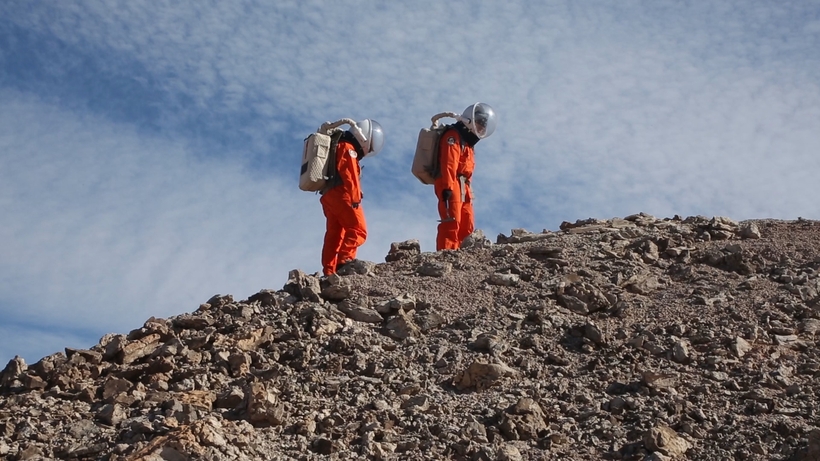Just two weeks before the coronavirus shut down New York, I traveled to the Kennedy Space Center in Merritt Island, Florida, to see SpaceX’s Dragon mission space launch. With me was Brooklyn artist Janet Biggs, whose conceptual piece, Finding Equilibrium, was one of several artworks chosen by the MIT Media Lab’s Space Exploration Initiative (SEI) to participate in the rocket’s 30-day mission to the International Space Station. Passing strip malls and rehab centers, we drove from Orlando to Cape Canaveral at sunset, listening to a space-heavy playlist: Bowie’s “Space Oddity,” Elton John’s “Rocketman,” even Ernie crooning “I Want to Visit the Moon.”
Standing out in a field—the equivalent of a press room at Space Center—under a clear night sky, we watched the Falcon-9 rocket lift off Launch Complex 40 at 11:50 P.M. It was like a hydrogen bomb going off: first the fumes turned the sky bright white, then a sonic boom pierced the air, deafening even from our post three miles away.
Little by Little
When I first heard that artworks were going into space, I imagined Jeff Koons’s Balloon Dog or Murakami’s happy-face flowers—a sort of modern-day equivalent of the Warhol drawing flown to the moon by Apollo 12. Instead, the chosen works were both niche and incredibly small, all needing to fit the 9-inch-tall box called Sojourner 2020. Japanese artist Masahito Ono sent a microfiche of the 2016 Paris Climate Change Agreement in a vial filled with Parisian air, an homage to Marcel Duchamp’s 1919 50cc of Paris Air. Native American artist Erin Genia contributed a miniscule sculpture based on the legend of a woman who turned into a falling star, made from the traditional Dakota material canupa inyan. Nine groups of artists were chosen in all, representing an international array of countries in an idealistic nod to universality in the cosmos.
Biggs selected stones from three different atmospheres for her own work: a sliver of a moon meteorite, a pebble from a Mars Simulation site, and a crystal from her grandfather’s rock collection. “This was a way of connecting to myself as a little girl,” says Biggs, “watching the 1969 Apollo landing and thinking there’s no place for me, no evidence of girls or women, in that world of possibilities.”
Japanese artist Masahito Ono sent a microfiche of the 2016 Paris Climate Change Agreement in a vial filled with Parisian air, an homage to Marcel Duchamp’s 1919 50cc of Paris Air.
More than 50 years later, the world is a different place. What started out innocently enough with Neil Armstrong’s “giant leap for mankind” proclamation quickly evolved into an imperialistic competition now categorized by concerns over “the military, resource extraction, or national expansion,” says Xin Liu, the Chinese artist and engineer and Curator of MIT’s SEI, after the launch. Xin sees the art initiative as a way of injecting creatives into the conversation. “We are proposing a different narrative,” she says, “where the only way forward is through collaboration, instead of who-gets-there-first.”
Today, firsts in the arena of space exploration are generated by billionaires racing to get to Mars. Tesla cofounder and C.E.O. Elon Musk, who believes that manifest destiny has a future elsewhere, has Space X, whose Falcon 9 rocket costs $57 million to launch. (That’s the rocket that took Sojourner 2020 into the sky.) Musk has announced that we will reach Mars as early as 2024 and that with his help we will build a city of one million people there by 2050. No one knows who will have this option to escape planet Earth if global warming—or the next pandemic—makes life impossible here, and who won’t.
Meanwhile, Amazon owner Jeff Bezos, the richest man in the world, is spending $1 billion a year on Blue Origin, a private spacecraft enterprise geared toward taking tourists on suborbital flights for a ticket price of at least $250,000, for the thrill of weightlessness and some killer views. Who will be able to take advantage of this opportunity? Not every kid who has a telescope pointed to the sky.
There was a time when I thought art could be accessible and comforting to all of humanity, just like watching the Apollo landing on a black-and-white television alongside 600 million other people felt like the quintessence of universal. When New York first entered lockdown, before the New York Times’s demoralizing report that the coronavirus is hitting blacks and latinos at double the rate of whites, or the New York Post’s stories on the class warfare playing out in the Hamptons, there was hope that this pandemic’s silver lining would be its universality. There are no better moments than these to look to artists, all of them now working in isolation, for a wider lens through which to see our future—even if their art is zoomed to space by a $33 billion company racing for space supremacy.
Barbara Pollack is the founder of the Web site How Can We Think of Art at a Time Like This?

